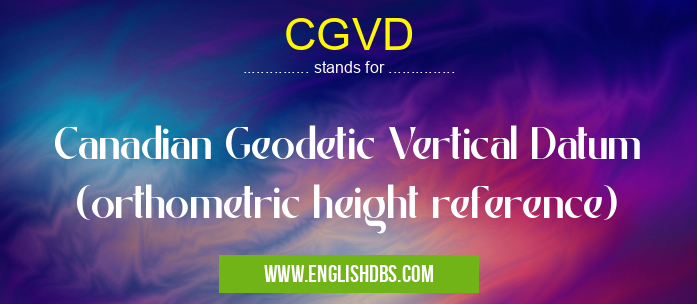What does CGVD mean in CANADIAN
Canadian Geodetic Vertical Datum (CGVD) is a geodetic vertical datum used in Canada to define the orthometric height reference for the country. It is a fundamental reference surface from which elevations are measured and is essential for surveying, mapping, engineering, and other applications that rely on accurate height information.

CGVD meaning in Canadian in Regional
CGVD mostly used in an acronym Canadian in Category Regional that means Canadian Geodetic Vertical Datum (orthometric height reference)
Shorthand: CGVD,
Full Form: Canadian Geodetic Vertical Datum (orthometric height reference)
For more information of "Canadian Geodetic Vertical Datum (orthometric height reference)", see the section below.
Understanding CGVD
- Geodetic Vertical Datum: A reference surface used to determine the vertical position of points on the Earth's surface.
- Orthometric Height: The height of a point above the geoid, a mathematical surface that approximates mean sea level.
- CGVD28: The original CGVD established in 1928, based on mean sea level at Father Point, Quebec.
- CGVD1988: A revision of CGVD28, adopted in 1988, which improved the accuracy and consistency of the datum.
Applications of CGVD
- Surveying and mapping: Defining elevations for land surveys, property boundaries, and topographic maps.
- Engineering: Designing and constructing buildings, roads, and other infrastructure.
- Hydrology: Understanding water flow and drainage patterns.
- Climate science: Monitoring sea level rise and other coastal changes.
Essential Questions and Answers on Canadian Geodetic Vertical Datum (orthometric height reference) in "REGIONAL»CANANDAPROVINCES"
What is Canadian Geodetic Vertical Datum (CGVD)?
The Canadian Geodetic Vertical Datum (CGVD) is a standardized reference point used to measure the vertical position of points on the Earth's surface in Canada. It is based on mean sea level at Father Point, Quebec, and was established by the Geodetic Survey of Canada in 1928. CGVD is commonly used in surveying, mapping, and other geospatial applications.
What is the difference between CGVD and other vertical datums?
CGVD is specific to Canada, while other vertical datums are used in different regions or countries. Each vertical datum is based on a different reference point and may have different elevation values for the same point on the Earth's surface. It is crucial to use the correct vertical datum for the geographical area being measured to ensure accurate elevation measurements.
Why is CGVD important?
CGVD provides a consistent and accurate way to measure vertical positions in Canada. It is essential for various applications, including surveying, mapping, construction, and land use planning. By using CGVD, professionals can ensure that measurements are compatible and reliable, eliminating confusion and potential errors.
How do I use CGVD?
To use CGVD, you will need to obtain the elevation data referenced to CGVD. This data can be obtained from various sources, such as government agencies, surveying companies, or online databases. Once you have the elevation data, you can use it in GIS software or other applications that support CGVD.
Is CGVD still used in Canada?
Yes, CGVD is still widely used in Canada. However, Natural Resources Canada is currently transitioning to the Canadian Vertical Datum 2013 (CVVD2013), which is a more modern and accurate vertical datum. CVVD2013 is expected to replace CGVD gradually over time.
Final Words: CGVD is a critical reference system for height measurements in Canada. It enables accurate and consistent surveying and mapping, supports engineering projects, and provides essential data for scientific research and environmental monitoring. Its importance extends across various sectors, making it a fundamental tool for understanding and managing the country's geography and infrastructure.
